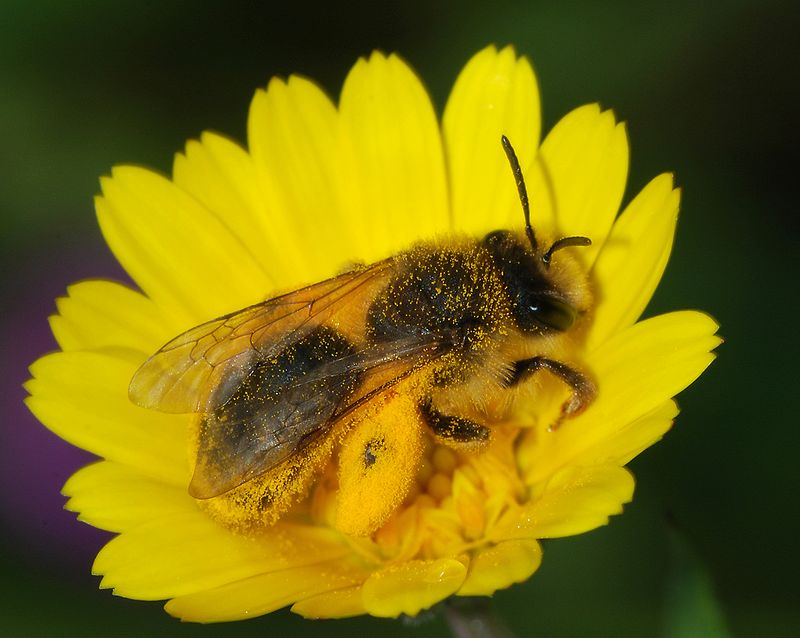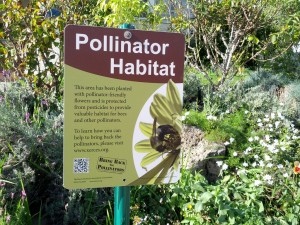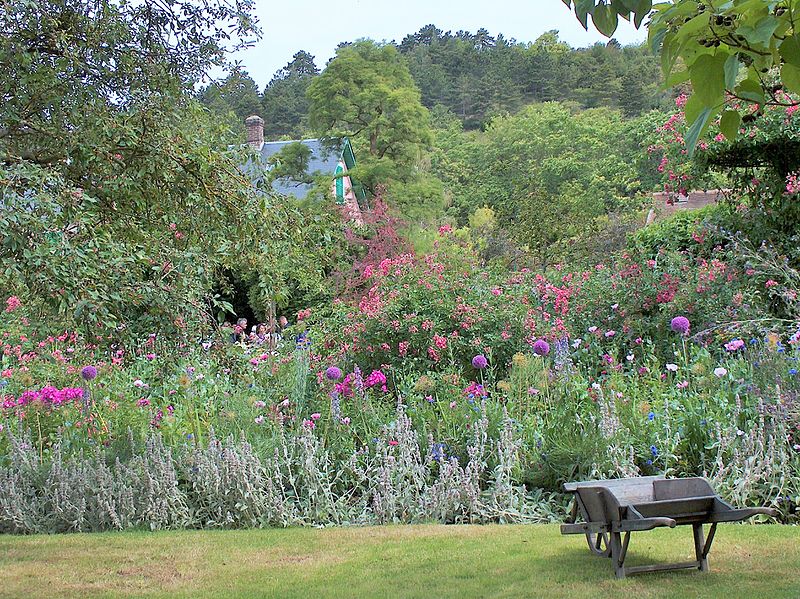In praise of messiness (a.k.a. healthy biodiversity)
On my twice-monthly drive on Highway 416 between Prescott and Ottawa, I pass the sign for Kemptville, a town of about 3,500 which lies roughly 40 km north of the St. Lawrence. It has a rich history, and no doubt is a fine place to live, but one of these days I need to stop there to verify that Kemptville is in fact a village of surpassing tidiness. (It’s Exit 34 in case anyone wants to take some field notes and get back to me.)

A large number of solitary wild ground-nesting bee species are among the native pollinators who thrive in a “messy” North Country environment. Andrena sp. bee with a full load of pollen on a Calendula flower. Photo: Alvesgaspar, Creative Commons, some rights reserved
Most of us would prefer not to live in totally unkempt surroundings, but Western culture may have taken sanitation a bit too far. Claims that cleanliness is next to godliness have yet to be proven by science, but research does indicate a neat, well-coiffed landscape is bad for bees and other pollinators.
With all due respect to honeybees, they are seldom required to produce fruits and vegetables. Please don’t spread this around, as I do not want to tarnish their public image. But the fact is that wild bees, along with other insects and the odd vertebrate here and there, do a bang-up job pollinating our crops, provided there are enough types of wild plants (i.e., messiness) around to keep them happy for the rest of the season.
As landscapes become neater and less diverse, wild bees cannot find enough natural foods to keep them in the neighborhood for the few weeks of the year we’d like them to wallow around in our apple or cucumber flowers. In sterile, highly manipulated environments like almond groves and suburban tracts, honeybees are critical.
Dr. Scott McArt, a bee specialist at Cornell’s Dyce Laboratory for Bee Research, says there are an estimated 416 species of wild bees in New York State. When I estimate stuff, the numbers tend to be less exact, such as “more than three,” but I’ve met Dr. McArt, and I trust him on this count. Dr. McArt is quick to point out that wild critters take care of things just fine in most places. He has cataloged exactly 110 species of wild bees visiting apple blossoms in commercial orchards, and in the vast majority of NYS orchards studied, honeybees have no bearing on pollination rates. My object is not to malign honeybees, but to point out that if we learn to live with a bit more unkemptness, we will improve the health of wild bees, wildflowers, food crops, and ourselves in the process.

A messy but pollinator-friendly (and proud of it) front yard. Photo: Akos Kokai, Creative Commons, some rights reserved
Messiness also takes pressure off managed honeybees, an increasingly fragile species, by providing them a rich source of wild, non-sprayed nectar and pollen. Orchardists do not spray insecticides when their crops are flowering because they know it will kill bees. But many fungicides, which are not intended to kill insects, are sprayed during bloom. One of the unexpected findings of research done through the Dyce Lab is that non-lethal sprays like fungicides are directly linked with the decline of both wild bees and honeybees. But banning a particular chemical is not a panacea—the situation is far more complex than that. What is needed to save bees of all stripes is a real change in mindset regarding landscape aesthetics.
Increasing the entropy on one’s property is as easy as falling off a log (which of course is a literal example of increased entropy). Pollinators need plants which bloom at all different times, grow at various heights, and have a multitude of flower shapes and structures. For greater abundance and diversity of wild flowering plants, all you need to do is stop. Stop constantly mowing everything. Choose some places to mow once a year in the late fall, and others where you will mow every second third year. Stop using herbicides, both the broadleaf kind and the non-selective type.

Maybe shoot for something like this – garden of painter Claude Monet, Giverny, France. Photo: Ibex73, Creative Commons, some rights reserved
Before you know it, elderberry and raspberry will spring up. Woody plants like dogwoods and viburnums will start to appear. Coltsfoot and dandelions, essential early-season flowers, will come back. Asters and goldenrod (which by the way do not cause allergies), highly important late-season sources of nectar and pollen, will likewise return.
Wild grape, virgin’s bower, Virginia creeper and wild cucumber will ramble around, without any help whatsoever. However, you may choose to help this process along by sowing perennial or self-seeding wildflowers like purple coneflower, foxglove, bee balm, mint, or lupine. Even dandelion is worth planting. You’ll not only get more wild pollinators, you’ll also see more birds. Redstarts, tanagers, orioles, hummingbirds, catbirds, waxwings and more will be attracted to such glorious neglect. No feeders required.
I strongly advocate for more chaos in the plant department, even if the local Chamber of Commerce or Tourism Board frowns upon it. Remember, just because you’re an unkempt community doesn’t mean you have to change the name of your town.
Paul Hetzler is a horticulture and natural resources educator with Cornell Cooperative Extension of St. Lawrence County.








One thing you can say about the Adirondack Forest, it is a total, unkempt mess – which is a good thing.
Easy to recognize your articles without scrolling to the bottom…love the humor. But Paul, I don’t want to “shoot” for anything, not even diversity. I will encourage diversity, however.